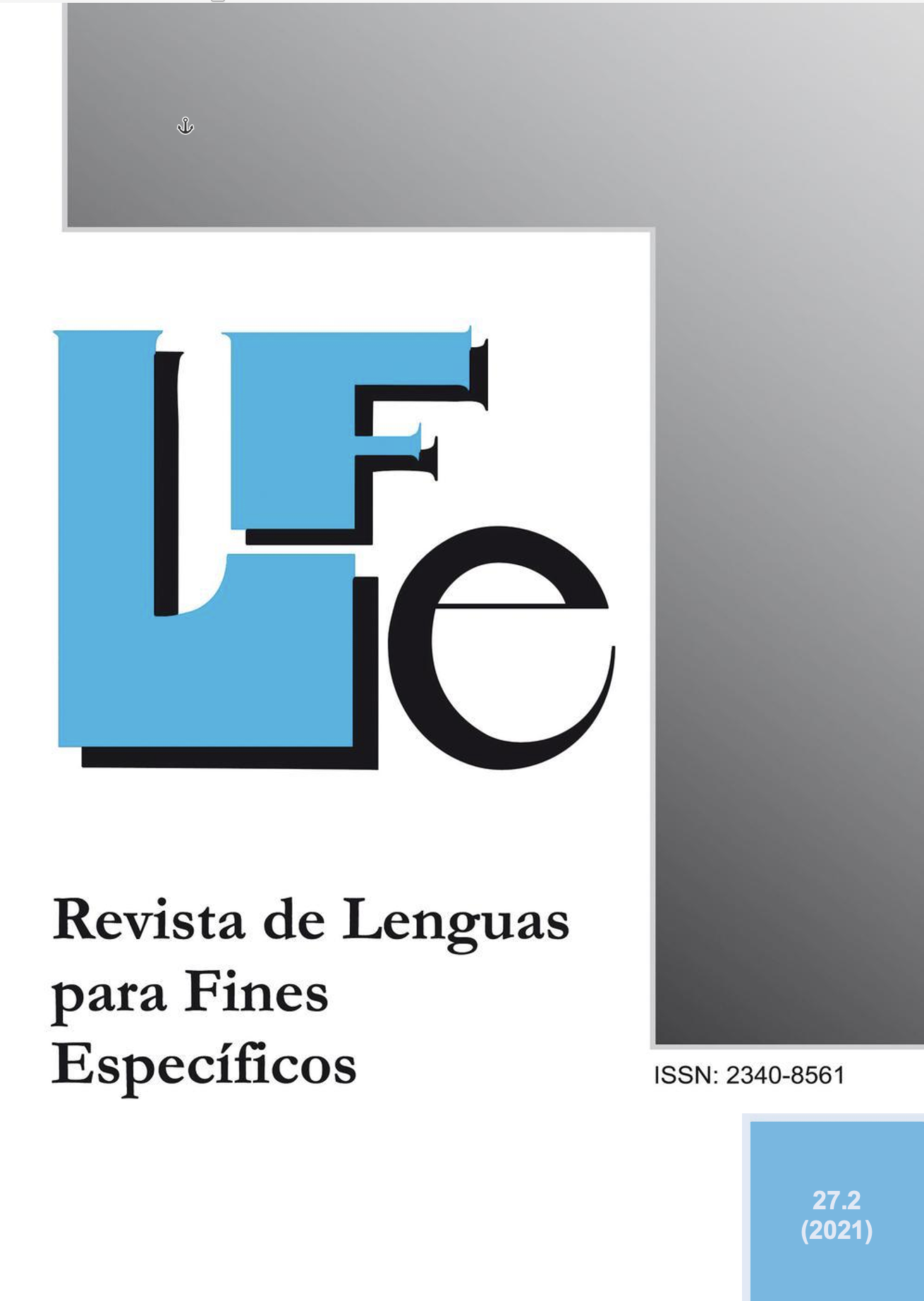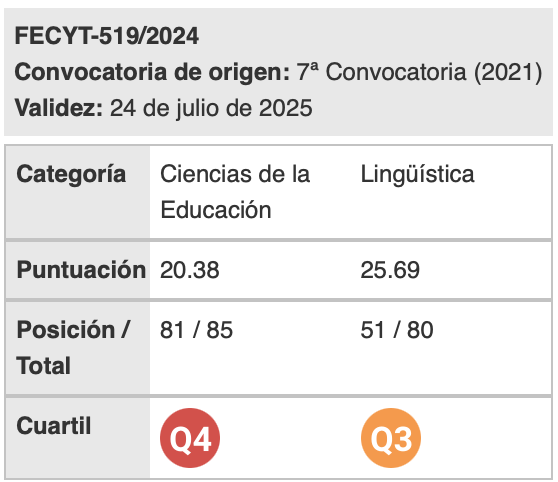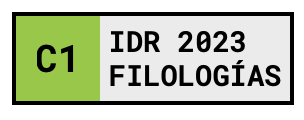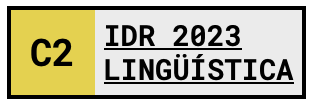La elección de medios de evaluación por el alumnado universitario
Keywords:
means of evaluation, coevaluation, authentic learning, university education, web pagesAbstract
The participation of university students in their own assessment is understood as an opportunity to improve students’ involvement in their learning. It also promotes the development of essential skills such as responsibility, reflection on their own learning and autonomy. The objective of this study is to explore the possibility of allowing university students to choose the means by which they will be assessed in a specific unit. Thus, an individual task related to the use of new technologies for the teaching of foreign languages was designed. Students choose how to be assessed on this topic, selecting between three different assessment options with three different grades. Contrary to expectations, the students chose the most complex task. According to the results of a final survey, the main reasons for this decision are the novelty and personal challenge involved in carrying out this task and the interest in designing a tool that will be needed in their future teaching profession. Finally, the educational web pages designed by the students are analysed according to a model for the study of digital genres.
Downloads
References
Askehave, I. & Nielsen, A.E. (2005). Digital genres: a challenge to traditional genre theory. Information Technology & People, 18(2), 120-141. DOI 10.1108/09593840510601504.
Birenbaum, M. (1996). Assessment 2000: Toward a pluralistic approach to assessment. En M. Birenbaum & F. Dochy (eds.), Alternatives in assessment of achievement, learning processes and prior knowledge (pp. 3-29). Boston: Kluwer.
Boud, D. (2000). Sustainable assessment: rethinking assessment for the learning society. Studies in Continuing Education, 22(2), 151-167.
Boud, D. (2007). Reframing assessment as if learning was important. En D. Boud and N. Falchikov (eds.), Rethinking assessment in higher education: Learning for the longer term (pp. 14–25). Londres- Nueva York: Routledge.
Boud, D. & Associates (2010). Assessment 2020: Seven propositions for assessment reform in higher education. Sydney: Australian Learning and Teaching Council.
Boud, D. & Falchikov, N. (2007). Rethinking assessment in higher education: Learning for the longer term. Londres-Nueva York: Routledge.
Boud, D., Lawson, R. & Thompson, D.G. (2015). The calibration of student judgement through self-assessment: Disruptive effects of assessment patterns. Higher Education Research & Development, 34(1), 45-59. http://dx.doi.org/10.1080/07294360.2014.934328
Brown, G.T.L. (2019) Is Assessment for Learning Really Assessment? Frontiers in Education, 4, 1-7. doi: 10.3389/feduc.2019.00064
Crisp, G. (2007). The e-Assessment Handbook. Nueva York: Continuum.
Dochy, F. Segers, M. & Sluijsmans, D. (1999). The use of self-, peer and co-assessment in higher education: A review. Studies in Higher Education, 24(3), 331-350. DOI: 10.1080/03075079912331379935
Falchikov, N. (1986). Product comparisons and process benefits of collaborative peer group and self-assessments. Assessment & Evaluation in Higher Education, 11(2), 144-166.
Falchikov, N. & Goldfinch, J. (2000). Student peer assessment in higher education: A meta-analysis comparing peer and teacher marks. Review of Education Research, 70(3), 287-322. http://dx.doi.org/10.3102/00346543070003287
Fernández Pérez, M. (1996). El campo de la lingüística aplicada. Introducción. En Fernández Pérez, M. (coord.). Avances en Lingüística Aplicada (pp. 11–46). Santiago de Compostela: Universidade de Santiago de Compostela.
Freitas, S. de. (2005). The Paradox of Choice and Personalization. En S. de Freitas & C. Yapp. Personalizing Learning in the 21st century (pp. 13-16). Stafford: Network Educational Press.
Gibbs, G. (2006a). Why assessment is changing. En C. Bryan & K. Clegg (Eds.), Innovative Assessment in Higher Education (pp. 11-22). New York: Routledge.
Gibbs, G. (2006b). How assessment frames student learning. En C. Bryan & K. Clegg (Eds.), Innovative Assessment in Higher Education (pp. 23-36). New York: Routledge.
Gielen, S., Dochy, F. & Onghena, P. (2011). An inventory of peer assessment diversity. Assessment & Evaluation in Higher Education, 36(2), 137-155.
Gielen, S., Dochy, F., Onghena, P., Struyven, K. & Smeets, S. (2011). Goals of peer assessment and their associated quality concepts. Studies in Higher Education, 36(6), 719-735.
Gijbels, D., Watering, G. & Dochy, F. (2005). Integrating assessment tasks in a problem‐based learning environment. Assessment & Evaluation in Higher Education, 30(1), 73-86. http://dx.doi.org/10.1080/0260293042003243913
Gómez-Ruiz, M.A., & Quesada Serra, V. (2020). Análisis de las calificaciones compartidas en la modalidad participativa de la evaluación colaborativa entre docente y estudiantes. Relieve, 26(1), 1-19. http://doi.org/10.7203/relieve.26.1.16567
Goñi Zabala, J.M. (2005). El espacio europeo de educación superior, un reto para la universidad. Competencias, tareas y evaluación, los ejes del currículum universitario. Barcelona: Octaedro-ICE.
Gutiérrez-García, C., Pérez-Pueyo, A., Pérez-Gutiérrez, M. & Palacios-Picos, A. (2011). Teacher trainers' and trainees' perceptions of teaching, assessment and development of competences at teacher training colleges, Culture and Education, 23(4), 499-514, DOI: 10.1174/113564011798392451
Hamodi, C., López Pastor, V.M. & López Pastor, A.T. (2015). Medios, técnicas e instrumentos de evaluación formativa y compartida del aprendizaje en educación superior, Perfiles Educativos, XXXVII(147), 146-161.
Holzinger, H.J. (2006). Hacia el EEES: Cambios en metodología y evaluación en la asignatura alemán como segunda lengua en la Universitat de València (España). Revista de Lingüística y Lenguas Aplicadas, 1, 49-62.
Hortigüela, D., Pérez-Pueyo, A. & González-Calvo, G. (2019). Pero… ¿A qué nos Referimos Realmente con la Evaluación Formativa y Compartida?: Confusiones Habituales y Reflexiones Prácticas. Revista Iberoamericana de Evaluación, 12(1), 13-27.
Ibarra Sáiz, M.S. & Rodríguez Gómez, G. (2010). Los procedimientos de evaluación como elementos de desarrollo de la función orientadora en la universidad. Revista Española de Orientación y Psicopedagogía, 21(2), 443-461.
Ibarra Sáiz, M.S., Rodríguez Gómez, G. & Gómez Ruiz, M.A. (2012). La evaluación entre iguales: beneficios y estrategias para la práctica en la universidad. Revista de Educación, 359, 206-231. http://dx.doi.org/10.4438/1988-592X-RE-2011-359-092
Kiliç, D. (2016). An examination of using self-, peer-, and teacher-assessment in higher education: A case study in teacher education. Higher Education Studies, 6(1), 136-144. DOI: 10.5539/hes.v6n1p136
López Pastor, V.M. (2012). Evaluación formativa y compartida en la universidad: clarificación de conceptos y propuestas de intervención desde la Red Interuniversitaria de Evaluación Formativa. Psychology, Society, & Education, 4(1), 117-130.
Luque Agulló, G. (2004-5). El dominio de la Lingüística Aplicada. RESLA, 17-18, 157-173.
Mims, C. (2003). Authentic learning: A practical introduction and guide for implementation. The Meridian Journal, 6(1), 1-3.
Newmann, F. & Wehlage, G. (1993). Five standards of authentic instruction. Educational Leadership, 50(7), 8-12.
Newton, P.E. (2007) Clarifying the purposes of educational assessment. Assessment in Education, 14(2), 149-170. DOI: 10.1080/09695940701478321
Padilla Carmona, M.T. & Gil Flores, J. (2008). La evaluación orientada al aprendizaje en la Educación Superior: Condiciones y estrategias para su aplicación en la docencia universitaria. Revista Española de Pedagogía, 66(24), 467-486.
Pérez de Albéniz Iturriaga, A., Escolano Pérez, E., Pascual Sufrate, M.T., Lucas Molina, B. & Sastre i Riba, S. (2015). Metacognición en un proceso de aprendizaje autónomo y cooperativo en el aula universitaria. Contextos Educativos, Revista de Educación, 18, 95-108.
Pérez Pueyo, A., Tabernero B., López, V.M., Ureña, N., Ruiz, E., Caplloch, M., González, N. & Castejón, F.J. (2008). Evaluación formativa y compartida en la docencia universitaria y el Espacio Europeo de Educación Superior: cuestiones clave para su puesta en práctica. Revista de Educación, 347, 435-451.
Pishtari, G., Rodríguez-Triana, M. J., Sarmiento-Márquez, E. M., Pérez-Sanagustín, M., Ruiz-Calleja, A., Santos, P., P. Prieto, L., Serrano-Iglesias, S., & Väljataga, T. (2020). Learning Design and Learning Analytics in Mobile and Ubiquitous Learning: A Systematic Review. British Journal of Educational Technology, 51(4), 1078–1100.
Quesada Serra, V., Rodríguez Gómez, G. & Ibarra Saiz, M.S. (2017). Planificación e innovación de la evaluación en educación superior: la perspectiva del profesorado. Revista de investigación educativa, RIE, 35(1), 53-70.
Rodríguez-Gómez, G., Ibarra, M., Gallego-Noche, B., Gómez-Ruiz, M.A. & Quesada-Serra, V. (2012). La voz del estudiante en la evaluación del aprendizaje: un camino por recorrer en la universidad. Relieve, 18(2). DOI: 10.7203/relieve.18.2.1985
Rodríguez Gómez, G., Ibarra Saiz, M.S. & García Jiménez, E. (2013). Revista de Investigación en Educación, 11(2), 198-210.
Rodríguez Gómez, G., Ibarra Saiz, M.S. & Cubero Ibáñez, J. (2018). Competencias básicas relacionadas con la evaluación. Un estudio sobre la percepción de los estudiantes universitarios. Educación XX1: Revista de la Facultad de Educación, 21(1), 181-208
Sluijsmans, D., Dochy, F. & Moerkerke, G. (1999). Creating a Learning Environment by Using Self, Peer- and Co-Assessment. Learning Environments Research, 1, 293-319.
Schmitt, N. & Celce-Murcia, M. (2002). An overview of applied linguistics. En N. Schmitt (ed.), An introduction to applied linguistics (pp. 1-16). Londres: Arnold.
Thomas, G., Martin, D. & Pleasants, K. (2011). Using self- and peer- assessment to enhance students’ future-learning in higher education. Journal of University Teaching & Learning Practice, 8(1), 1-17.
Topping, K. (1998). Peer Assessment between Students in Colleges and Universities. Review of Educational Research, 68(3), 249-276.
Topping, K. (2009). Peer Assessment. Theory into Practice, 48(1), 20-27.
Vallejo Ruiz, M. & Molina Saorín, J. (2014). La evaluación auténtica de los procesos educativos. Revista Iberoamericana de Educación, 64,11-25.
Villaroel, V. & Bruna, D. (2019). ¿Evaluamos lo que realmente importa? El desafío de la evaluación auténtica en educación superior. Calidad en la educación, 50, 492-509.
Referencias electrónicas
https://www.bbc.co.uk/learningenglish/
https://www.blogger.com/about/?bpli=1
https://www.classdojo.com/en-gb/
http://formativeassess.weebly.com/flipquiz.html
https://www.learnclick.com/favicon.ico?lang=en
Downloads
Published
How to Cite
Issue
Section
License
Authors who publish with this journal agree to the following terms:
- Authors retain copyright and grant the journal right of first publication with the work simultaneously licensed under a Creative Commons Attribution License that allows others to share the work with an acknowledgement of the work's authorship and initial publication in this journal.
- Authors are able to enter into separate, additional contractual arrangements for the non-exclusive distribution of the journal's published version of the work (e.g., post it to an institutional repository or publish it in a book), with an acknowledgement of its initial publication in this journal.
- Authors are permitted and encouraged to post their work online (e.g., in institutional repositories or on their website) prior to and during the submission process, as it can lead to productive exchanges, as well as earlier and greater citation of published work (See The Effect of Open Access).

Revista de Lenguas para fines específicos is licensed under a Creative Commons Reconocimiento-NoComercial-SinObraDerivada 4.0 Internacional License.

























